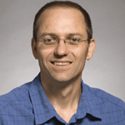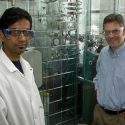Facility provides researchers powerful tool
Researchers can rapidly test tens of thousands of small, organic chemical compounds for their ability to alter biological processes at the Keck-UW Comprehensive Cancer Center Small Molecule Screening Facility, one of a handful of university facilities of its kind in North America.
Called high throughput screening, the powerful, state-of-the-art research tool traditionally has been available only inside biotechnology and pharmaceutical companies, which usually used it to develop drugs for treating disease.
An academic facility’s purpose is broader, says the screening facility’s founder and director, Michael Hoffmann, a UW–Madison professor of oncology and medical genetics, and leader of the cancer center’s Experimental Therapeutics section.
“On this campus there are 800 biology labs asking a whole variety of biological questions. Any of those labs could use this facility — its use is very general,” he says. “We’ve worked with faculty members in the traditional therapeutic areas of biochemistry and cancer biology. But we’ve also worked with people from plant pathology and entomology.”
The facility was established in 2002 with funds from the UW Comprehensive Cancer Center, the UW Keck Center for Chemical Genomics and the Graduate School. Since beginning operations in May 2003, the facility has completed 13 screens for eight campus laboratories. The facility’s staff scientists are Noel Peters and Marilee Karamanski.
The UW–Madison facility has two collections, or libraries, of compounds, one containing 16,000 molecules, and the other 20,000. The molecules are chosen for their “drug-like” properties, including their relatively small size, their propensity to bind reversibly to other molecules, and for their structural diversity and extreme novelty.
The facility’s workhorse is its state-of-the-art robot, which meticulously mixes cells, proteins or other biological materials with each and every molecule in the libraries. Performed by hand, such testing would take weeks or months. The robot can test the biological activity of every compound in the two libraries in a day.
The robot’s work is the shortest part of the process, says Peters, who helped start the first academic high-throughput screening facility five years ago at Harvard University. Scientists who want to perform a screen must first purify large quantities of their “target,” such as a protein or cell type, and then develop a test, or assay, that the robot can perform within the tiny wells of 96 or 384 well plates.
Some researchers already possess a well-developed assay when they approach the screening facility, says Peters. “And some people come in with a protein in a test tube and say, ‘I want to screen for inhibitors of this enzyme. How can I do that?'”
The facility can assist with assay development at any stage. “There’s a strong educational aspect to this facility,” says Hoffmann. “We’re essentially training people on campus to design high-throughput screening assays.”
The facility charges UW–Madison scientists a nominal fee to cover the cost of disposable labware, supplies and staff time. Information: http://hts.wisc.edu, or, noelpeters@wisc.edu.
Tags: biosciences, research



